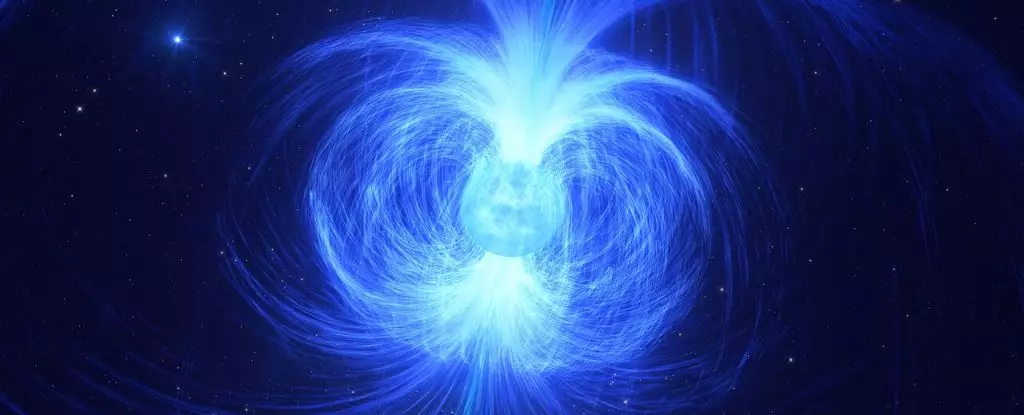The universe is an ever-intriguing puzzle, peppered with celestial phenomena that consistently defy our understanding. Among these enigmas is the phenomenon known as fast radio bursts (FRBs), brief yet immensely powerful spikes of radio emissions. Recent astronomical advancements have traced one such burst, designated FRB 20190208A, back to an unexpected source—a tiny dwarf galaxy located billions of light-years away. This discovery adds another layer of complexity to the evolving narrative of FRBs and challenges existing assumptions about the cosmic locations associated with these phenomena.
Typically, astronomical research has indicated that FRBs predominantly originate from large, star-forming galaxies. However, the faintness of the host galaxy associated with FRB 20190208A shatters this stereotype. Danté Hewitt of the University of Amsterdam articulates the surprise that comes with discovering an FRB’s source in one of the least massive galaxies recorded. By employing an extensive observational approach, including over 65 hours of data collection, astronomers have been able to decode this unique burst. Such precision enables scientists to delve deeper into the origins of the radio emissions—efforts that illuminate the suitability of various celestial environments for FRB production.
Moreover, the newfound dwarf galaxy doesn’t just embody a numbers game; it serves as a metaphor for the forgotten corners of the universe, where unusual entities thrive against the odds. In contrast to mainstream beliefs about cosmic phenomena being housed in grand stellar arenas, this elusive galaxy invites us to explore the minor narrations of the universe, which often hold key insights.
Fast radio bursts are particularly enigmatic due to their transient nature. Typically lasting only milliseconds, these monumental bursts release energies equivalent to that of 500 million solar masses. This scale of energy makes them impossible to predict accurately, drawing astronomers into a labyrinthine trail of perplexity and wonder. Conventional wisdom categorized most FRBs as unique instances, but those that repeatedly emit bursts, such as FRB 20190208A, open the door to more targeted investigations. These recurring events offer a tantalizing glimpse into the conditions that give rise to their origins, harboring secrets waiting to be uncovered.
The current hypothesis points towards magnetars—highly magnetized neutron stars—being culprits for some FRB emissions. Yet, the variety of FRBs challenges this assumption, indicating that the narrative surrounding them is far from complete. This latest research encourages astronomers to reconsider what we think we know about FRBs and what conditions might give rise to the countless facets of these cosmic bursts.
The arduous effort to pinpoint the host galaxy for FRB 20190208A yielded unexpected results. Initial searches yielded no conclusive findings, labeled as ‘hostless’ FRBs, a phenomenon that typically raises eyebrows in the astronomical community. Eventually, a focused effort revealed a faint image of the dwarf galaxy, a moment celebrated by the research team. This revelation showcases the unpredictability of astronomical exploration, reinforcing the notion that discovery often lies in persistence and meticulous observation.
The implications of finding an FRB in such a faint galaxy are profound. Dwarf galaxies, characterized by their lower metallicities, are interesting locales for stellar activity. The discovery implies that environmental conditions within these galaxies could be conducive to the formation of the stellar remnants that produce FRBs. This paints a picture of a dynamic universe where the interplay of stellar evolution and cosmic phenomenon is more intricate than previously believed.
The research posits that the paradigm surrounding FRBs may connect more closely to the life cycles of massive stars inhabiting dwarf galaxies. The death throes of these stars culminate in core-collapse supernovae and leave behind magnetars that might be responsible for emitting the flashes of energy we observe as FRBs. This notion evokes a poetic reflection on the cyclical nature of the cosmos, where explosive endings give rise to new beginnings—rippling through the void of the universe with their brilliant signals.
This compelling narrative is still in development, a work in progress filled with questions poised to unravel with each new discovery. Understanding the connection between dwarf galaxies and FRBs is not merely a matter of academic inquiry; it’s a journey toward appreciating the very nature of the universe itself. As researchers delve deeper into these cosmic signals, we find ourselves inching closer to unraveling one of the most beautiful mysteries that dwell within the dark expanses of the cosmos. The essence of FRB 20190208A is not just in its rarity but rather how it encourages a reassessment of the universe’s manifold secrets waiting to be uncovered.


Leave a Reply